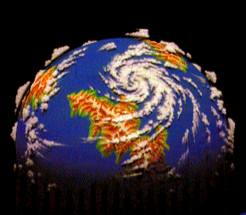Laymans media
https://www.space.com/climate-change-termination-event-end-ice-age
Academic source
https://agupubs.onlinelibrary.wiley.com/doi/10.1029/2023GB007875
Plain Language Summary Atmospheric methane’s unprecedented current growth, which in part may be driven by surging wetland emissions, has strong similarities to ice core methane records during glacial-interglacial “termination” events marking global reorganizations of the planetary climate system. Here we compare current and termination-event methane records to test the hypothesis that a termination-scale change may currently be in progress.
ABSTRACT
Atmospheric methane’s rapid growth from late 2006 is unprecedented in the observational record. Assessment of atmospheric methane data attributes a large fraction of this atmospheric growth to increased natural emissions over the tropics, which appear to be responding to changes in anthropogenic climate forcing. Isotopically lighter measurements of 13Cch4 are consistent with the recent atmospheric methane growth being mainly driven by an increase in emissions from microbial sources, particularly wetlands. The global methane budget is currently in disequilibrium and new inputs are as yet poorly quantified. Although microbial emissions from agriculture and waste sources have increased between 2006 and 2022 by perhaps 35 Tg/yr, with wide uncertainty, approximately another 35–45 Tg/yr of the recent net growth in methane emissions may have been driven by natural biogenic processes, especially wetland feedbacks to climate change. A model comparison shows that recent changes may be comparable or greater in scale and speed than methane’s growth and isotopic shift during past glacial/interglacial termination events. It remains possible that methane’s current growth is within the range of Holocene variability, but it is also possible that methane’s recent growth and isotopic shift may indicate a large-scale reorganization of the natural climate and biosphere is under way.
It’s been fun hanging with you guys. See you when the simulation resets
From article:
But in late 2006, something “very, very odd” happened, he said. Methane started rising again, but there was no dramatic shift in human activity to blame — and researchers were left scratching their heads. Then, in 2013, Nisbet and his colleagues realized this rise was accelerating. By 2020, methane was increasing at the fastest rate on record, he said.
From Wikipedia - Fracking in the United States:
Source link: http://www.economist.com/node/21556242 - Shale of the century - The “golden age of gas” could be cleaner than greens think
archive link: https://archive.is/dRIT - Article dated: Jun 2nd 2012
We’ve definitely set off methane deposits in the arctic, the ocean, the tropics, etc. But acting like there’s no way of knowing this could have happened or why is just stupid. The global shale oil boom set off by US development of new extraction technologies due to OPEC pressure, the use of which then spread around the globe is definitely a major contributing factor.
For the majority of the early phase of the fracking boom up to now, methane was vented as they were trying to maximize oil extraction. Pipelines and methane capture equipment were not in place in many locations and have only begun to be due to the rise in LNG prices resulting from Russian supply destabilization. Further, these were known risks at the time that were ignored with a concern only for maximizing oil production and profits.
This should surprise no one.
Further documentation:
Fracking boom tied to methane spike in Earth’s atmosphere
The chemical signature of methane released from fracking is found in the atmosphere, pointing to shale gas operations as the culprit.
https://www.nationalgeographic.com/environment/article/fracking-boom-tied-to-methane-spike-in-earths-atmosphere
Archive link: https://archive.is/BvHZg#selection-4479.0-4483.133 - Article dated: Aug 15, 2019The reason this is more relevant and not just fracking stufff is this. Its added ON TOP OF THE FRACKING RELEASES! **
Isotopically lighter measurements of 13Cch4 are consistent with the recent atmospheric methane growth being mainly driven by an increase in emissions from microbial sources, particularly wetlands.**
Very true. And, the additional context of the abrupt phase is super valuable in telling us where we are in our current timeline of shifting climate patterns. There’s definitely important research here that significantly advances understanding.
It’s just the “scratching their heads”, ‘how could this have happened, it’s so unexpected’ bloviating that’s constantly prattled over in any of these articles… Drives me crazy. Should drive everyone crazy.
We’re in the midst of a seriously massive great extinction, quite possibly greater than the Chicxulub impact event, and researchers have been trying to put a stop to it for decades, sounding every alarm in the process. Everyone knew, but a small percentage of powerful people have driven us all headlong into the fire. Those most at fault even funded and then hid some of the most significant research into the topic years before the scale of it became wider public knowledge. We should be blaming, accepting blame and being stark in our declarations about what, in general at the very least, is happening, is about to happen and why. The constant hand waving is fucking bullshit.
that delta carbon-13 curve is unsettling
What’s delta carbon-13?
i’m looking at figure 3 in the academic source.
delta carbon-13 is a measure of the ratio of carbon-12 vs. carbon-13 in a sample, in this case in samples of atmospheric methane gas. the lower the value, the fewer carbon-13 isotopes there are relative to carbon-12 isotopes. carbon-13 is stable, it doesn’t radioactively decay.
https://en.wikipedia.org/wiki/Δ13C
so if you can date samples of atmosphere trapped in ice cores and measure the amount and isotopic composition of the methane then you can construct a graph like that figure 3. different processes result in distinct isotopic signatures for the methane released into the atmosphere. what their chart shows is that from about 1100 c.e. to 1900 c.e. the delta carbon-13 ratio dropped by about 2 per-mil while atmospheric methane concentration rose, which they attribute to a decrease in biomass burning sources of methane and an increase in agricultural sources of methane.
then in 1900 c.e. there’s a big increase in atmospheric methane along with a big increase in delta carbon-13. fossil fuel sources of methane are much heavier than natural sources, so as trapped methane was released into the atmosphere it produced a sharp change in the isotopic ratio.
but then about 15 years ago the isotopic signature sharply reversed course even as methane concentration started suddenly rising more rapidly. so something weird is going on these past two decades where we’ve possibly already started feedback loops that result in releasing trapped permafrost methane, for example. the paper suggests it’s mostly from tropical wetlands, but the focus of the paper is on the isotopic observations.
deleted by creator
this is the clathrate gun, correct? so we’re utterly fucked?
The big clathrate gun may not happen, it’s still just a theoretical. But what is happening is like constant little fireworks all the time going off…same long term effect really.
paper says tropical wetland microbial action, so not clathrates yet, no.
thanks!
deleted by creator








